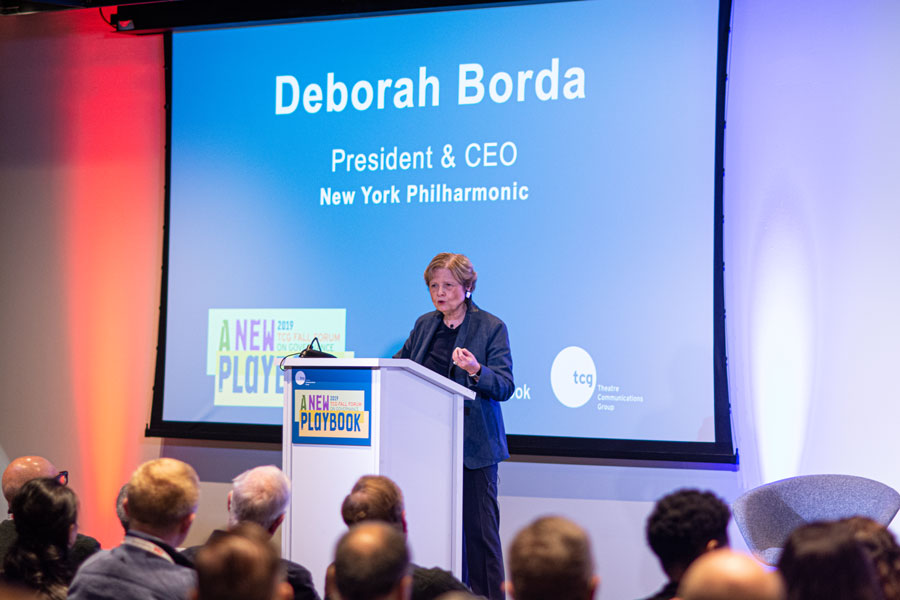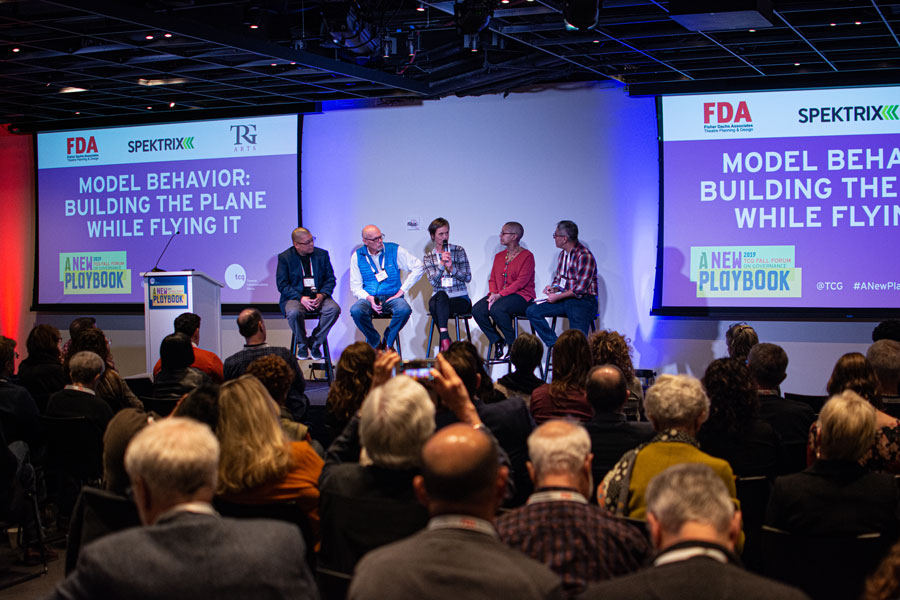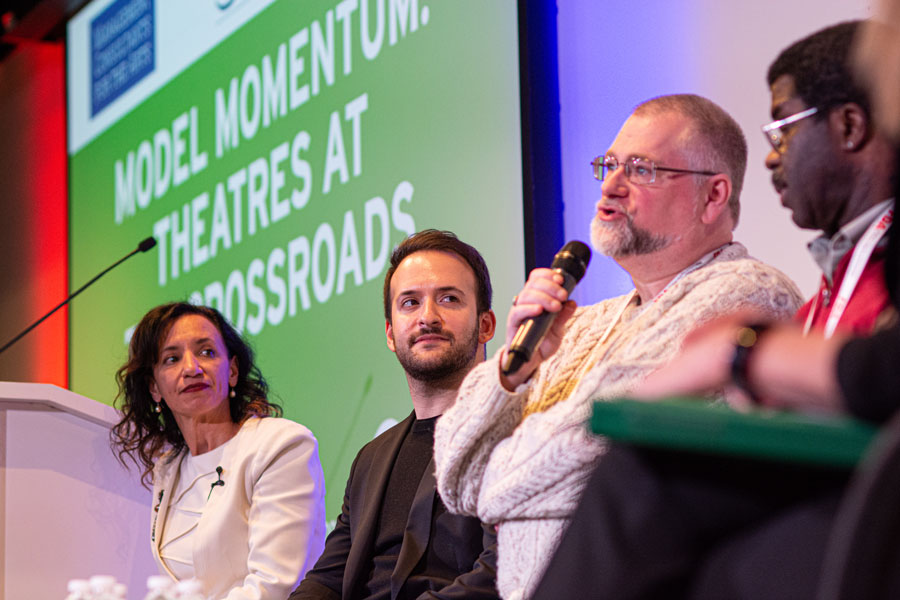This year’s Theatre Communications Group (TCG) Fall Forum on Governance, “A New Playbook,” offered innovative tools, questions, and strategies for building organizational strength, relevance, and sustainability. The weekend convening in New York City, Nov. 8-10, brought together theatre leaders, board members, and practitioners at Convene in Midtown Manhattan for a deep-dive examination of our current nonprofit model, which gave those gathered the opportunity to learn from the past and imagine where we are heading in the future. What might a new playbook for the American theatre look like? How might the strengthening of our institutions also strengthen our communities?
The opening night kick-off party on Friday at the Library at the Public Theater began with a fractal exercise led by Bryan Joseph Lee, associate director of Public Forum at the Public, and myself in my capacity as executive director of the Yale Indigenous Performing Arts Program, inspired by a reading-list item from last year’s forum, Emergent Strategy by adrienne maree brown. All participants were invited to imagine their theatre 10 years from now: What do you hope to keep and what do you want to leave behind over the next decade? When we think of the futures of our theatres, what kind of ancestors do we want to be?
Building on this question, Saturday morning began with an acknowledgement that not only did we stand on on Lenape land, but that the Lenape have lived in the region for thousands of years and still do. As Ryan Victor Pierce (Nanticoke Lenni-Lenape), artistic director of the Eagle Project, reminded us, “How did the Lenape live here for thousands of years? Sustainability,” meaning that they practiced equality with each other and with the land.
The opening plenary, “Model Makers: Innovation in Nonprofit Arts Leadership,” featured a woman who has impacted the legacy of two major arts institutions, the New York and the Los Angeles Philharmonic orchestras. Deborah Borda, currently the president & CEO of the New York Philharmonic, shared wisdom gleaned from her experiences in this realm, which began in 1999 when she arrived at the L.A. Phil, an institution that then faced critical financial problems, and over 17 years helped it get to a place of fiscal strength. She spoke passionately about the need to take risks in moments of dissatisfaction. “You aren’t innovative by forming an innovation committee,” she said. Real innovation requires real risk.
Among the initiatives she touted: Currently women conduct the NY Philharmonic’s youth concerts so that the first person that young people see conduct an orchestra is a woman, striving to undo the long-term assumptions created by a world in which most people grow up seeing only male conductors. This follows up on a long overdue transition that began with a policy shift in the 1960s, which has required auditions for the orchestra to be held behind a curtain, and which led to more women being hired in by the NY Phil.

The second plenary looked at our fiscal responsibilities close up. “Model Momentum: Theatre at the Crossroads,” led by Robert Rosener, first VP at Morgan Stanley, LLC, and Zannie Voss, director of SMU Data Arts, took a look into the fiscal future of our field and how best to prepare our theatres for the next economic downturn. Voss offered tangible action steps for theatres to prepare for the next recession. “These are the good times,” she said of the current economy. “Now is the time to think about what’s the story of your organization running into the next decline.” She suggested asking “those around you who were leading organizations in the last recession what they learned.” She drew attention not only to building savings, but to planning projects that can generate positive energy in lean or troubled times.
While the past offers one set of tools, there are other ways our organizations must evolve to stay relevant in relationship to a changing world. In the breakout session “New Rules of Engagement: Fundraising in a Multi-Generational Context,” Melissa Cowley Wolf, founder of MCW Projects, cited studies showing that millennials increasingly see philanthropy through a social justice lens. As she put it, “Multi-generational fundraising requires being a conduit to a cause.” How is the work you are doing impacting the world?
In another session, “All Aboard: Reimagining Contemporary Governance,” Yasmine Falk, founder and partner of Advance NYC; Trella Walker, associate director of advisory services for the Nonprofit Finance Fund; and Lisa Yancey, president of Yancey Consulting, engaged in critical dialogue around governance moderated by Nataki Garrett, the new artistic director of Oregon Shakespeare Festival. These incredible women helped us understand how successful governance requires that mission, vision, and values be in alignment throughout an organization. If you are not sure what your values are, Yancey explained, “Your budget to me tells the story of your values.” Added Walker, “If your mission doesn’t clearly state your social justice values, that is a mistake.”
As for vision, Yancey defined it as “what is happening seven generations from now? If we are doing this for a public good, what is that vision? What is the change you imagine as a result of your dedication? The world is changing, and sometimes the vision needs to pivot with a changing world.” Clear communication about mission, vision, and values helps set up a leader to succeed.
Sunday morning included an expanded exercise, again led by Bryan Joseph Lee and myself, in which we sought to go deeper into the opening night question: What do we keep and what do we leave behind? Many of the systems participants wanted to keep mirrored the creativity, patterns, and evolution of nature, whereas a lot of the structures we felt are no longer serving us were built on hierarchies and fear. Leslie Ishii shared how the work of decolonizing at the Perseverance Theatre on Vera Starbard’s play Devilfish empowered the creation of a beautiful work of art, enriched community dialogue, and brought in responsive audiences. The group gathered for this session requested that emails be collected at the end, as all seemed excited to continue the conversation about the future of our field together.
The closing session, “Model Behavior: Building the Plane While Flying It,” featured remarks from Eric Ting, artistic director of California Shakespeare Theatre; Blanka Zizka, founding artistic director of Wilma Theater; Chandra Stephens-Albright, managing director of Kenny Leon’s True Colors Theatre Company; and Edgar Dobie, executive producer of Arena Stage; the moderator was director Mark Valdez.
Ting talked about the work he has been doing to shift how people feel when they arrive at Cal Shakes. The American theatre, he said, has often operated as if to say, “Here is the table. It has been set for 40-odd years for a group of people who largely share similar experiences. Then at some point they add a couple chairs on the end for other people.” Of course, when you show up alone to join a table of strangers and are given a chair that has been added as an afterthought, you don’t feel comfortable and you’re unlikely to want to stay. “A couple empty seats at an empty table isn’t enough,” Ting said. “You have to set another table, and it is not just about who is sitting at those tables but also who is setting those tables.” Broadening the metaphor, he added: “While the food may get you to the table, it’s the company that keeps you there.”
By way of illustration, a slide show of all of Cal Shakes’s previous artistic directors depicted all white men with beards, and then finally Ting’s face at the end, standing out in contrast. He offered a reminder that hiring an artistic director of color is not just hiring a face. “Inviting a leader of color into a legacy white institution is an extraordinary act of courage,” he said. “And believe it or not, it is a new business model.”

Indeed, this moment of generational turnover is sometimes referred to as the “refounding of the American theatre.” It is a moment that raises the possibility of a real shift in the model of the American theatre as a new wave of artistic directors takes the helm. But hiring new leaders is just the first step; institutions also have to be willing to courageously support and empower the visionaries they bring into their theatres.
The Wilma’s Zizka then drew attention to a too often excluded topic: how we engage with our artists. She said that she had found that actors in ensemble theatres often develop a kind of fearlessness in their work, so she created a model that would offer actors a place to grow their craft. Her theatre brought in international artists and paid her actors to attend the workshops. “We all need to keep learning, exercise our craft, and experiment,” she said. “It is amazing how often care and respect for our artists get left out of the model of our theatres. After shows at the Wilma, this dynamic ensemble of actors will even stay and chat with audience members about the process.” In addition, Zizka spoke about a new initiative she’s instituted at the Wilma: a rotating artistic leadership model, in which artists take turns curating programming for a season at a time.
As I think about this moment of refounding and the potential to create a truly new playbook for our field, I keep thinking of something Ting said in that last session. “What is the way that we create the spaces, so they come for the work but more importantly for the company?” Making the crucial link between the audience and work onstage, he concluded, “They are coming to be in company with each other.”
This year’s reading recommendations:
The Art of Gathering: How We Meet and Why It Matters by Priya Parker
The Starfish and the Spider: The Unstoppable Power of Leaderless Organizations by Ori Brafman and Rod A. Beckstrom


